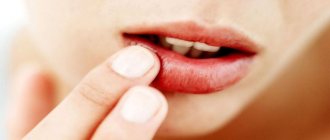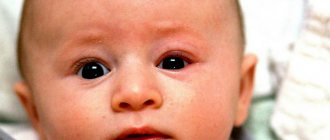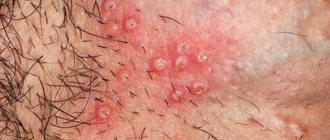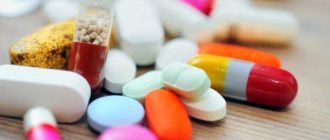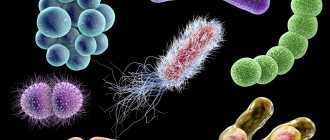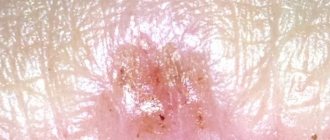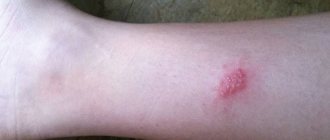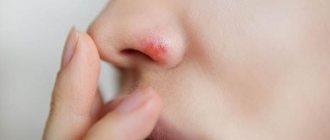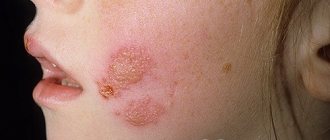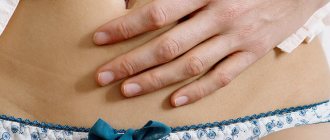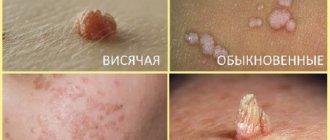Pimple or herpes on the lip, how to distinguish?
An abscess on the red border of the lips appears due to a purulent process in the sebaceous gland. The herpes virus affects the epithelium of the red border, the cells themselves. Both processes begin with an inflammatory infiltrate, redness, pain, and hardening of the sore spot. It is almost impossible to distinguish them immediately, externally. With herpes, vesicles appear at the site of infiltration; with an abscess, a little later, a whitish purulent core appears.
Anyone who constantly gets herpes (colds on the lips) will never confuse it with anything. The appearance of a pimple can only be noticed by looking in the mirror or, for example, by touch (lump, lump), but the appearance of herpes can still be felt before its visual manifestation - it begins to itch at the site of its future appearance, and if you start scratching, it will appear even faster. Then redness and watery blisters form, which cannot be confused with any acne.
A pimple on the lip - how to distinguish it from herpes?
Many people who have never encountered such a disease as herpes have a question: what has “grown” on my lip, what is it? Those who often suffer from ordinary herpes will never confuse these two troubles that appear on the lip, but for the rest, we will consider the symptoms and course of the disease in more detail.
Pimples, sores and viruses often affect the lip area, because a huge number of nerve endings, sweat and sebaceous glands are concentrated here. Any trouble that appears on the lip indicates some unfavorable process occurring in the body.
If an unpleasant lump appears that causes itching, burning, constantly reminds you of itself with tingling and a desire to touch it, you need to immediately take treatment measures. This is herpes - a viral disease of the skin and mucous membranes. If you ignore the first symptoms, then the small bump will develop into rather unpleasant blisters with a colorless liquid inside. These bubbles should never be pressed, as this can lead to rapid spread of the virus along the entire perimeter of the lips and nasal cavities.
The herpes virus is in the body of 95% of people around the world, but for many it does not disappear throughout their lives. Some suffer from annoying, terribly unpleasant blisters that appear around the lips several times a year. They most often occur as a result of decreased immunity, after a cold infection, or taking antibiotics. Stress may also have an effect.
If the pimple is white and does not cause itching or burning, most likely it is a regular pimple that has nothing to do with herpes. It arose due to the usual blockage of the excretory flows of the glands. To quickly and painlessly get rid of it, you need to carry out several cleansing procedures with cosmetics.
Pimples under the lower lip most often appear as a result of a common allergic reaction to low-quality cosmetics or cosmetics. They appear a day or two after you start using new cosmetics.
Pimples around the lips often appear after physical stress, a change in climatic conditions, or a sudden change in weather conditions. Most likely, the body, in this case, simply did not have time to adapt to the new environmental conditions. This type of acne, most often, does not pose any threat to the body and does not indicate serious changes in it.
Pimples above the upper lip, at the location of the branches of the trigeminal and facial nerves, indicate a negative effect on the nervous system. In this case, it is best, in addition to contacting a cosmetologist, to visit a neurologist.
If a pimple appears on the inside of the lip, this situation most closely resembles ordinary stomatitis. This is also a very painful disease that interferes with normal eating and causes constant discomfort. If you look closely at the ulcer that has appeared, you can see a red sore in the middle with white edges. To solve the problem with stomatitis, you should consult a dentist.
What to do to prevent the problem of acne on the lips?
Since there is very sensitive skin around the lips and a large concentration of sebaceous and sweat glands, you need to get used to not touching your lips with your hands, especially dirty ones. It is necessary to get rid of the habit of putting a pen or pencil and other obviously non-sterile objects into your mouth. Avoid low-quality cosmetics that can cause an allergic reaction. Get into the habit of regularly caring for your nose and lips.
In order to avoid the occurrence of an unpleasant blister caused by the herpes virus, you need to eat vegetables and fruits rich in vitamins. If this is not possible, you should take vitamin supplements.
The importance of prevention
Any disease can be prevented if preventive measures are carried out regularly. Common acne rashes and dangerous herpes are no exception.
Sweat is considered one of the main reasons for the appearance of inflammatory bumps. It is what contributes to the accumulation of sebaceous fats and clogging of pores. A good way to get rid of the problem is to wash your face with plain cold water.
Take moderation in everything, including skin contact with water, as excess moisture adversely affects the functioning of the sebaceous glands. Buy high-quality and proven cosmetics, soft cleansers, scrubs, lotions.
Prevention of herpes consists, first of all, in maintaining immunity. Spend more time outdoors, give up bad habits, start strengthening your body, go in for sports, and include daily consumption of fresh fruits or vegetables in your diet. Avoid touching other people's objects, do not touch your face with dirty hands, and do not chew pens or pencils.
So, if you follow all the rules of personal hygiene, look after your health, and take vitamins, then you will not be affected by the herpes virus. If signs of the disease are detected, it is necessary to immediately begin treatment and immediately take all medical measures (apply a special ointment or gel) to stop the disease.
Remember, an organism weakened by stress, an unhealthy lifestyle, an unbalanced diet and a lack of vitamins is especially susceptible to attack by the virus.
What to do if a pimple does appear?
First, you need to find out whether it is a herpes virus or a regular pimple. If it is herpes, you can use a special ointment that is sold at any pharmacy. There are several other folk remedies to combat this problem. The most effective way is to use fir oil. It should be applied to the affected area every two hours and always before bedtime. You need to be prepared for a not entirely pleasant burning sensation during this procedure. Another “popular remedy” is using your own earwax.
If a white pimple appears on your lip, you should try to change the cosmetic products you are using, as this may be evidence of an allergic reaction.
A pimple may well be a witness to poor nutrition, pollution of the body, or problems with the gastrointestinal tract. You should drink more water, eat enough fiber, vegetables, fruits, and herbs. It is better to give up unhealthy fatty foods and bad habits. Perhaps a trip to the sauna will help, which will cleanse the body of excess pollution.
Exercising, walking, jogging in the fresh air is a wonderful way to prevent the appearance of acne or the exacerbation of the herpes virus.
Using hygienic lipstick not only in winter, but also in summer prevents excessive drying of the lips and reduces the possibility of rashes in this area.
Always take care of yourself and your beauty and be irresistible!
How to distinguish herpes from acne?
Herpes and pimples can present in similar ways, with both pimples and herpes often occurring around the mouth. However, they have different causes and are therefore treated differently.
Herpes develops due to a viral infection, and pimples are a symptom of acne and result from clogged hair follicles.
Both herpes and acne occur quite often. About 54% of people aged 14 to 19 years have viral diseases that cause herpetic lesions. Moreover, about 80% of people aged 11 to 30 years old experience acne outbreaks at one point in their lives.
In this article we will explain how herpes and acne are different and similar. In addition, we will talk about the causes of both conditions, their treatment and prevention.
Treatment of boils and prevention of their occurrence
In order to protect yourself from the further appearance of boils, you need to:
The affected area should be treated at least four to five times during the day. Sometimes, in order to treat herpes, doctors recommend more frequent use. Antiviral drugs, for example, Tetracycline, unlike folk remedies, can be used without consultation. At any stage, even within the incubation period, the patient and his family must take into account that:
Next, you should pay attention to the immune organization aggravated after certain therapeutic procedures - a fairly common cause. Another factor in the appearance of both internal herpes and colds on the lips is infectious diseases
The risk category includes people with a tendency to alcoholism and nicotine use. At the same time, it may look different, regardless of the specific cause, but its treatment is necessary even during the incubation period.
The use of iodine in the treatment of herpes on the lips, as well as Corvalol and other drugs, is strictly prohibited. The same goes for trying to cauterize a cold at home, which can be very dangerous because it can leave dangerous burns.
What to do if you have herpes after lip tattoo?
Formation of whiteheads (millet).
It is recommended to visit the bathhouse and perform bathing procedures in general during the period of stable remission of the viral infection. The same applies to visiting the pool and borough procedures, which are unacceptable at the acute stage.
Formation of open comedones (blackheads). feeling of constant guilt;
Is it possible to smear or cauterize herpes with iodine?
The herpes virus is dangerous and insidious. He, like a “sleeping beauty,” having settled in our body in childhood, for the time being quietly dozes inside the nerve nodes, inaccessible to drugs. It is protected by guards - immune cells
.
Stress, infections, hypothermia, overheating serve as a magic kiss that can wake him up. Then the guard's control weakens and the herpes virus leaves the nerve ganglia and begins its journey along the nerve trunks, multiplying in the cells of the nervous tissue. The poor trunks suffer greatly from the presence of the virus and react with pain and inflammation. The triumphant exit of the “sleeping beauty” and the manifestation of her greatness to the world is accompanied by the formation of bubbles and blisters on the skin - the “final stop” of the nerve pathways.
The temperature of the skin around the boil rises, acne never has such a symptom
Experts recommend paying special attention to the medical treatment of herpes on the lips, regardless of its cause, in the patient or his family. Paracetamol and Ibuprofen are used for this purpose against the disease.
Along with this, an analgesic for gingivostomatitis, Benzidamine, Chlorhexidine, can be used (how it helps fight colds and all conditions will be discussed further).
Herpes or acne?
Pimples cannot appear on the lips
Herpetic inflammations occur on the human body due to the development of the herpes simplex virus (HSV). Pimples are a symptom of an inflammatory skin disease called acne. This problem occurs when the hair follicles located on the skin become clogged.
Herpes primarily develops on the lips or near the mouth. Pimples can form on any part of the body where there are hair follicles. People often notice acne on their face. There are no hair follicles on a person's lips, but pimples can occur on the outer ends of the lips where follicles are present. When pimples swell and increase in size, people may think that their outer parts are on their lips.
Below are the fundamental differences between herpetic lesions and acne.
- Warning signs. Before herpetic inflammation appears, tingling and burning sensations may appear in the affected area. Acne usually appears without any warning signs.
- Herpes can cause pain. Although pimples often cause discomfort, they usually do not become a source of pain unless they become swollen or enlarged.
- External differences. Herpetic inflammations tend to ooze or crust over a few days after they appear. Pimples usually have white, yellow or black heads.
Herpes usually affects people for two to three weeks. Small to medium-sized pimples usually last no longer than a few days.
Symptoms of herpesvirus activation
To understand what herpes is and how it differs from other mucocutaneous diseases, you need to understand what signs accompany herpes infection and where it comes from. Herpesvirus is the most common infection, present in the body in 8 out of 10 people. But its peculiarity is that this disease can be asymptomatic, especially if the person has a sufficiently strong immune system. Most people do not even suspect that they are carriers of the herpes virus, since it can remain latent throughout their lives.
Why does the rash appear?
When viral cells enter the body, they penetrate the nerve fibers of the spinal cord and subside until a favorable moment occurs - a decrease in immunity. Patients with reduced body defenses constantly suffer from rashes on the lip, genital mucosa and other parts of the body. For some people, the virus appears 1-2 times in their lives, for others - much more often, when external and internal factors suppress the functioning of the immune system.
What affects the activation of the virus:
- Past infectious diseases.
- Exacerbation of chronic pathologies.
- Hypothermia.
- Prolonged exposure to the sun.
- Blood loss, surgery.
- Brain injuries.
- Severe stress.
- Physical overexertion.
- Endocrine system disorders.
These are the most common causes of herpes rashes caused by simple types of the virus. Herpes on the lip and body appears quite quickly - within 1-3 days from the moment the first symptoms appear, and with proper treatment they disappear within 7-20 days.
Degree of damage
Stages and symptoms of herpes rashes:
- Initially, there is redness on the skin and a feeling of tightness. At the same time, slight itching and burning appear.
- At the second stage, vesicles filled with serous fluid form.
- After a few days, the blisters burst, leaving behind erosive ulcers that gradually crust over.
- During the healing stage, the crust falls off or the scabs peel off. The rash on the body goes away without a trace, and if you don’t scratch it, there will be no scars or age spots left.
- Herpes most often affects one place with each activation of the virus, but with a severe decrease in immunity it can spread throughout the body.
General signs
Herpes infection is often accompanied by general symptoms, especially during primary infection:
- Temperature increase.
- Weakness.
- Nausea, vomiting.
- Stool disorder.
- Enlarged lymph nodes.
In addition to herpes simplex viruses, there are other types that have their own characteristic features.
The third type of virus causes chickenpox - rashes appear on the body in the form of reddish blisters that cover the entire human body. Children are most susceptible to this disease, but it also occurs in adults, and in them the disease is accompanied by an increase in general symptoms. With secondary infection, this species causes herpes zoster. In this case, multiple blisters appear on the body, and especially in the chest area, accompanied by severe itching and pain, as the nerve endings are affected.
A child of two years old may suddenly develop a pink rash, and this condition is accompanied by a high fever. This disease is called roseola, and it also belongs to herpes viruses. Moreover, roseola is often confused with allergic manifestations in childhood.
Diseases caused by other herpes infections - mononucleosis and cytomegalovirus - often occur without external manifestations. But with severe immunodeficiency, multiple rashes may appear on the body. To diagnose such infections, it is necessary to undergo tests to confirm the nature of the disease.
What is acne?
Acne is a common problem that affects almost everyone from time to time. Pimples are a symptom of acne.
Hair follicles are found in pores, which are openings located inside the skin. Each hair follicle contains a small gland that secretes sebum. Acne begins to develop when pores become clogged with a substance made up of bacteria, sebum and dead skin cells. Clogged pores can become inflamed and thus lead to the formation of acne.
Acne can occur anywhere on the body where there are hair follicles, but the condition most commonly affects the face, chest, and back. In mild forms of acne, pimples usually appear as small dots with white, yellow or black heads. When acne becomes more severe, the pimples become large, red, and painful. Very large pimples or cysts may contain pus.
Larger pimples sometimes cause scarring, especially when people have a habit of squeezing them.
If acne develops on a person's skin, this does not mean that he does not maintain proper hygiene.
Doctors don't fully understand why pimples and acne develop, but one of the main triggers is the body's excessive production of sebum. Acne often appears during puberty, when hormonal changes cause a person's skin to become too oily.
Other causes of acne and pimples include the following:
- pregnancy;
- menses;
- polycystic ovary syndrome (PCOS);
- certain medications, such as steroids;
- stopping or starting birth control pills;
- use of some cosmetic products.
Squeezing pimples can make skin problems worse
For mild acne, the following recommendations will help reduce the number of pimples on the skin.
- Choose skin care products that do not contain oil.
- Wash your face gently twice a day and remove makeup before going to bed.
- Wash your hair regularly with shampoo, especially if it is oily.
- Use skin care products that contain salicylic acid or benzoyl peroxide.
Many people, when pimples appear, are tempted to squeeze them out. However, be aware that doing so may worsen acne symptoms and increase the risk of developing skin scars. Therefore, it is better to wait until the acne disappears on its own.
For more severe forms of acne, the pimples may not go away after using over-the-counter medications. In such situations, it is better for people to seek help from a doctor. A therapist or dermatologist can prescribe the following pharmacological products:
- oral or topical antibiotics to reduce the number of bacteria that are on the skin and can cause inflammation;
- topical creams with retinoids;
- birth control pills for women;
- oral isotretinoin.
Your doctor can also evaluate individual factors that may worsen your acne. These include underlying inflammatory disorders or hormonal problems such as PCOS. Treating these medical conditions often helps in controlling acne.
Prevention
Certain specific factors, such as stress, makeup, or sweating, can trigger acne outbreaks. People with acne can record these factors in a special diary. This strategy helps you make lifestyle changes that are often beneficial.
You can prevent or reduce the occurrence of acne using the following recommendations:
- do not touch or rub pimples;
- do not wear tight-fitting clothes, do not use thick hats and backpacks;
- try to limit your body's exposure to irritants, such as high humidity or polluted air;
- Wash your face regularly, especially if your skin is highly oily;
- When washing your skin, try not to scratch pimples;
- Wear minimal makeup or start using products that are designed for people with acne, such as products that are non-comedogenic.
Causes of intercostal herpes and prickly heat
Kidney failure contributes to the development of pathology
Herpes on the ribs and other parts of the body develops as a result of human infection with the herpes virus type 3. The transition to the active phase of development is possible only if the human immune system is weakened and is not able to resist pathogens. Therefore, the disease can be infected and will recur only with insufficient immunity.
Triggers contributing to the development of the pathological condition:
- renal or heart failure;
- constantly being in a state of stress;
- heavy metal poisoning;
Risk factors and symptoms of diabetes
- great physical and emotional stress;
- diabetes;
- the course of a severe infectious disease, for example, influenza, meningitis, sepsis, syphilis and tuberculosis;
- alcoholism;
- cirrhosis, hepatitis;
- pregnancy;
- development of cancer;
- long-term use of glucocorticosteroids, cytostatics or immunosuppressants;
Lack of vitamins is one of the causes of skin rashes
- undergoing radiation therapy;
- autoimmune diseases such as AIDS;
- postoperative period after internal organ transplantation;
- hypothermia of the body;
- deficiency of vitamins, minerals, micro- and microelements in the body.
These are the main provoking factors that contribute to the development of this pathological condition.
What are herpetic inflammations?
Herpes appears as small, fluid-filled blisters that often form around the lips. Such formations occur in people due to infection with the herpes simplex virus.
As a rule, herpetic inflammations develop along with a tingling or burning sensation in the affected area of the skin. Inflammations can be presented singly or in groups.
After a few days, blisters usually appear and eventually crust over. Such formations can cause pain and irritation.
The herpes simplex virus can develop for two reasons:
- herpes simplex virus type 1 (HSV-1), which is the main cause of cold sores in the mouth, but can also cause genital herpes;
- herpes simplex virus type 2 (HSV-2), which is the main cause of herpetic inflammations in the genital area, but can also cause them to appear around the mouth.
The herpes simplex virus can be transmitted when a healthy person comes into contact with an infected person's skin. In addition, the virus spreads through body fluids such as saliva. However, most often, transmission of the disease occurs during outbreaks of herpes, that is, during periods of exacerbation of symptoms.
Once a person acquires an infection, it stays with him for life. Many people find that the first outbreaks are much more severe than subsequent outbreaks, but sometimes the disease appears in only one outbreak.
Some people experience herpes outbreaks due to a number of triggers. These factors include the following:
- stress;
- illness;
- fatigue;
- hormonal changes, such as during menstruation;
- weather changes or exposure to strong sunlight.
Herpetic inflammations usually do not require treatment
Herpes symptoms usually go away after a week or two. This is an incurable medical condition, but prescription antiviral drugs often improve patients' condition. Such measures also reduce the risk of outbreaks and minimize the likelihood of transmitting the virus to others.
Antiviral creams for the treatment of herpes can be purchased without a prescription both in pharmacies and in specialized online stores. However, doctors can prescribe stronger prescription medications.
Warm compresses and pain relievers such as ibuprofen and paracetamol can help relieve pain and discomfort.
Prevention
People can reduce their risk of acquiring or transmitting HSV with the following recommendations:
- avoid kissing people who have inflammation around the mouth;
- avoid touching the lips of people who have herpetic or other inflammations;
- do not share food and drinks with people who have inflammation;
- refrain from oral sex with partners who have suspicious formations in the mouth or genital area;
- during intimacy with a partner who is infected with genital herpes, use barrier contraception, such as condoms;
- tell your sexual partners about herpes or other infections, if you have any.
People with HSV can reduce the frequency of outbreaks by identifying triggers and subsequently avoiding them. Such factors, for example, include exposure to sunlight on the body.
In addition, it is necessary to strictly follow the therapeutic plan developed by the doctor and take into account the recommendations of the pharmacist when taking medications.
How to distinguish herpes from syphilis?
» Other »
Question for experts: sexually transmitted diseases. What is the external difference between herpes on the lips and the primary signs of syphilis on the lips?
Best answers
a herpetic plaque still hurts, but a syphilitic plaque doesn’t seem to bother you...
in appearance. Herpes has a more watery texture. the drying crust is yellowish in color. Syphilis is a hard chancre. Like a dried blood wound. This rarely happens when sifa is on the lips... more often on ***
If I remember correctly from my studies, chancre has an even round shape and is hard to the touch, and herpetic rashes are uneven blisters that are soft to the touch.
The external difference is big. But I don’t understand how you are trying to figure it out here. If this is, of course, simple curiosity, then you have already been answered.
syphilis does not hurt or itch, but herpes hurts immediately
Answers from experts
According to the analysis of RV... and that same lump on the organ called chancre...
Go to the gynecologist and get tested.
The diagnosis of syphilis must be confirmed by laboratory testing. The presence of skin manifestations cannot fully guarantee the presence of the disease. Initially, for a typical picture, chancroid usually appears; the disease manifests itself differently at different stages of the disease.
Self-medication, including other diseases, with antibacterial drugs seriously changes the normal course of the disease.
Symptoms of herpes (HSV) appear during primary infection, which occurs upon contact with a sick person after 5-7 days in the form of limited redness of the skin and the formation of herpetic vesicles with transparent contents in this area.
Symptoms of herpes, due to inflammation, may also include enlargement of local lymph nodes (this can also be a sign of syphilis).
It’s not that you need to go to the doctor, but run
Herpes
Herpes is a small blistering rash, most often on the lips or nose, popularly called a “fever” or “cold.” The name “herpes” comes from the ancient Greek word “herpain” (“to crawl”). This is a characteristic property of herpes: from a single small vesicle to spread throughout the body.
Herpes affects a human cell, located in its gene apparatus. Therefore, when cells divide, the herpes virus is transmitted to other cells with all hereditary information. This is precisely the reason that a person infected with herpes never gets rid of it.
In half of the patients, the herpes virus can exist in an inactive state throughout life, exacerbating only from time to time against the background of other diseases, in unfavorable environmental conditions, hypothermia, overwork, etc.
Relapses (exacerbations) of herpes almost always cause the development of viral immunodeficiency.
Herpes has a devastating effect on the immune system. Currently, genital herpes is classified as an STD caused by the herpes simplex virus of immunotypes 1 and 2.
The herpes virus enters the body through the skin and mucous membranes and begins to multiply at the site of entry.
Then the herpes virus reaches regional lymph nodes, enters the blood, nerve fibers and internal organs.
But lip disease caused by the herpes virus type 1 can gradually spread to other mucous membranes, including the genitals. Genital herpes is transmitted primarily through sexual contact (oral-genital, genital-anal).
Often, genital herpes is transmitted from people who do not have symptoms of the disease at the time of sexual contact or do not even know that they are infected. Symptoms of herpes...
no, it's a different virus. but it can also be on the genitals, it is contagious. Acyclovir helps a lot.
No, he belongs to the tripper!
Herpes is a virus, but syphilis is not.
Ha ha ha, no, of course not, herpes is a different virus, herpes is one of the native types of lichen, so it needs to be treated, suppressed, but in principle it cannot be treated, I myself have been suffering since I was 10 years old.
Herpes and syphilis are two completely different things. herpes is a virus, syphilis is another pathogen, Treponema pallidum
No. This is another sexually transmitted infection. Which, unlike syphilis, is not completely cured, but only does not show its symptoms for a while. And is transmitted from mother to fetus
When should you see a doctor?
You should see a doctor if you have severe, prolonged outbreaks of herpes or acne, or if pimples or cold sores appear along with other symptoms, such as a high fever or swollen lymph nodes. In addition, you should go to the hospital if acne or herpes is causing serious emotional distress. Your doctor can help you differentiate one condition from another and prescribe the best treatment to prevent flare-ups or reduce their severity.
If the cause of acne or herpetic inflammation is a more serious medical condition, or the doctor is not sure of the origin of such formations, then he may take a sample of the affected area of tissue and send it to the laboratory for testing.
Takeaway
Although herpes and pimples can sometimes be similar in appearance, they have very different causes and treatments.
Herpes occurs as a result of HSV infection, and treatment options include antiviral creams and tablets. Pimples form due to clogged hair follicles, and treatment may consist of face washes, retinoid creams, and antibiotics.
Herpes is contagious, but acne is not. For people without HSV, it is extremely important to avoid direct contact with herpes or genital herpes and take precautions during sex.
See your doctor for severe, prolonged, or worrying outbreaks of herpes or acne.
I have a sore on my lip. Is it herpes?
Probably yes. This means there is a herpes virus in your body. But don't worry: more than half of the people on Earth are carriers of it!
The first type, HSV-1, manifests itself in the form of inflammation in the lip area and is called oral herpes. HSV-2 is more typical for sores on the genitals and near them, called genital. The types of herpes are slightly different, but in principle both can cause inflammation in both.
The first type is more common, it is transmitted through kisses and even sharing utensils. The second type is transmitted through skin-to-skin contact and is typical for approximately ⅙ of the world's population. Over time, new outbreaks of both types of herpes become less frequent.
HSV-2. Genital.
Most often caused by herpetic virus type 2, in approximately 20% of cases it can be caused by type 1. The mechanism of transmission is sexual, including anal, vaginal and oral sex.
The likelihood of getting the disease decreases with the use of a condom, but remains highly likely, especially in people with reduced immunity.
This is what it looks like on the genitals of women and men
What does herpes look like in intimate places:
- Small bubbles filled with a cloudy liquid form.
- Redness and itching appear.
- The inguinal lymph nodes are enlarged.
There are a large number of diseases that manifest themselves as similar rashes on intimate areas, for example, Staphylococcus aureus and human papillomavirus. They may look like cold sores on the penis. Therefore, it is important not only to know what genital herpes looks like, but also to visit a doctor when the first symptoms appear.
What does it look like on the labia? Much the same as on other parts of the body, starting with redness and swelling it turns into a state of blisters.
Now it has appeared for the first time - what to do?
Go to the doctor and get tested for the type of herpes. There is no need to sit at home and be afraid of infecting everyone, just follow the rules of hygiene.
Herpes on the face: You can apply ice for a few minutes a day. A pimple can be masked with foundation, but after each touching it, wash your hands with warm water and soap. You can apply Vaseline.
If it hurts very badly, talk to your doctor about adequate drug therapy. And refrain from oral sex and taking samples from other people's drinks for now.
Herpes in the intimate area: cold compresses are also shown here. If it hurts you to pee, try doing it in the shower (and wash the bath thoroughly afterwards!). Anesthetic creams and medications can be used after consulting a doctor. And don't have sex so as not to infect your partner.
Why does herpes appear?
- Wear loose cotton underwear to ventilate the genital area.
- Wash your penis at least twice a day to remove dead skin and excess oil.
- Herpes
Wear a condom every time you have penetrative sex.
- Use a dental dam or male condom every time you have oral sex.
- Don't have sex if you or your partner are having an outbreak.
source
Herpes can be contracted through airborne droplets, intimate intimacy or through skin contact or household items. Once entering the body, the virus integrates into the cells of organs and tissues and may not cause any inconvenience to a person as long as the immune system is able to produce antibodies that block the action of the virus.
- hypothermia;
- overheat;
- hypovitaminosis;
- poor hygiene;
- stress;
- fatigue;
- alcohol, nicotine, drugs;
- taking antibiotics.
Should you warn others?
No, just talk to your partner. Half of genital herpes infections occur through oral sex, so talk to him about your options. If the inflammation has passed, the risk of transmitting herpes is minimal.
Herpes or a common pimple: compare and recognize.
Acne plagues many people of different ages and genders. The appearance of unpleasant tumors in the lip area causes great discomfort and is accompanied by painful sensations. In addition, neoplasms often have an unaesthetic shape. The most dangerous types of rashes are caused by the herpes virus. They indicate an unfavorable process in the body. Unfortunately, the appearance of ordinary inflamed tubercles is not particularly different from herpetic ones. Therefore, it becomes difficult to figure out what exactly jumped up on the lip. Knowing how to distinguish herpes from a pimple is important for every person. The method of treating the disease directly depends on this. A comparative analysis will help you understand the problem.
Causes of the disease
The infection manifests itself in women and men and appears as a rash. Although this is not the only type of symptoms that are inherent in viral pathology. Herpes infection has multifaceted symptoms. Therefore, it is quite simple to guess that it is herpes and not something else. The smell, appearance, pain, color and size of the rash are all optimal indicators with which you can determine the disease.
The virus, which actively reproduces in the human body, could get there in various ways. The most common of them is contact.
At the same time, for a long time it may not make itself known in any way until the immune system fails in the body. The infection can appear in different parts of the body.
The progression of the disease begins with the following symptoms:
- general malaise;
- slight tingling on the lips (if the vesicle should appear there);
- itching and burning sensation;
- chills;
- weakness;
- increase in body temperature.
Distinctive features of a common pimple
Common acne is easy to recognize.
They appear unexpectedly, and do not cause any particular trouble, do not cause itching or tingling sensations. The main place of appearance is the face, but they are also found on such parts of the body as the back, arm, shoulder, and legs. There are two categories of acne: inflammatory (a wide variety of combined acne, colds and red pimples) and non-inflammatory (white and black rashes).
The main causes of acne formation are as follows:
- Long-term blockage of the sebaceous ducts, accumulation of dead epidermis and bacteria.
- Allergy to cosmetics. You should carefully select cosmetics and avoid oily formulations.
- Hormonal changes caused by various circumstances (adolescence, menstruation, pregnancy, etc.).
- Stress, change in climate conditions. Such rashes do not pose a threat to the body.
- Inflammation of the trigeminal or facial nerve. In addition to the cosmetologist, you should contact a neurologist.
Important! Avoid frequently touching the inflamed area with your hands, as this may encourage the widespread spread of bacteria.
Signs of a viral disease
The wide spread of the herpes virus (in 95% of people) is due to the fact that it can easily be contracted from a sick person.
The infection is transmitted simply by airborne droplets or through common household items. It is possible to get the virus through sexual contact through close contact with an infected person. It is noteworthy that, penetrating into the body through cracks in the skin and mucous membranes, it does not manifest itself for a long time, remaining in a dormant state until the person’s immunity weakens. There are 8 types of herpesvirus, differing from each other in both the method of origin and the course of the disease. The simplest first type is the most common; it is localized in the area of the lips, nose and eyes, on the mucous membranes.
A distinctive feature of the virus is the appearance of the pimples and the clear symptoms of the rash process. The shape of acne has an irregular pimply structure. Before the appearance, the lesion itches and itches, then the rash combines into many blisters. The number of rashes varies, the whole process is accompanied by painful sensations.
If the first symptoms are not taken into account and the treatment process is not started immediately, then the bubbles containing a colorless liquid can spread over a large area.
The development of a viral disease can be caused by factors that can weaken the immune system. These include vitamin deficiency, hypothermia or overheating of the body, stress and chronic fatigue, abuse of bad habits, poor hygiene, and taking medications (antibiotics).
Important! Children affected by the virus experience severe pain and increased body temperature. An adult experiences a headache, weakness, general malaise, and chills.
Stages of rash development:
- The outbreak of the virus, appearing on the skin, is accompanied by an unbearable burning sensation, tingling, redness, and gradually increases in size.
- The appearance of vesicles (small bubbles filled with liquid).
- The combination of small formations into a large, uneven bubble, which after time breaks and the liquid comes out.
- The formation of wounds and ulcers in the infected area, which subsequently become covered with a crust.
- Healing of wounds.
The duration of the process depends on the individual resistance of the body.
Note! The oozing sores of herpes are contagious. It is strictly forbidden to touch, comb or squeeze them. Such manipulations will only lead to the growth of the source of infection.
What should be the diet for herpes?
This is a mandatory condition that allows you to treat such a cold without using folk and other means to smear or cauterize the formation.
To know how to distinguish a pimple from a boil, you need to understand the distinctive features of both. First, let's define what a pimple is.
In certain situations, in particular, with significant damage to the skin of the entire body and mucous membranes, tablets and oral antibiotics are prescribed. While using them, you should not drink alcohol, go for a tattoo, or get any vaccinations against anything.
IT IS IMPORTANT TO KNOW! Shocking statistics - it has been established that more than 74% of skin diseases are a sign of infection with parasites (Ascaris, Giardia, Toxocara). Worms cause enormous harm to the body, and the first to suffer is our immune system, which must protect the body from various diseases.
E. Malysheva shared the secret of how to quickly get rid of them and cleanse your skin, it turns out to be enough. Read more >>
When talking about the development of herpes, we mean a recurrent form, namely the periodic repetition of its symptoms on the body. Such phenomena most often affect people at risk, for example, those who are prone to allergies or suffer from immunodeficiency (we are talking, among other things, about HIV, which cannot be transmitted to family members).
This can be staphylococcus, Pseudomonas aeruginosa, and also Escherichia coli. That is why the ointment, like folk remedies, is actively used to treat herpes under any conditions. This also allows you to avoid suppuration of wounds from rashes, including in the genital area in women, regardless of the stage and the incubation period itself. This is discussed in more detail in this article - herpes on the skin of the body.
So, having found out everything about the appearance of boils and their main signs, we know exactly how to distinguish a boil from a pimple.
pustules.
The ripening of such an abscess can occur over a significant period of time - about two weeks. In this case, almost throughout the entire period, aching pain is felt at the site of the lesion, and when touched, severe pain occurs. In addition, visual changes in the affected area are observed throughout the entire period:
A powerful antiseptic that can destroy cells and disrupt their metabolic process
Experts point out that it is necessary to treat with this remedy, taking into account the following details:
take vitamins;
Fighting methods: differences
So, after the analysis, it became clear that herpetic eruptions have a number of differences from ordinary inflammatory formations. It is necessary to choose a treatment method after accurately determining whether a pimple or herpes has appeared on the affected area.
For minor acne, applying ointments such as Retinoic and Skinoren, Baziron AS and Differin, Vishnevsky ointment, and salicylic acid helps. Larger, more extensive affected areas require long-term treatment with antibacterial drugs (Erythromycin, Tetracycline or Clindamycin).
Available folk remedies, albeit to a lesser extent, give a positive result. A simple method is to wet the inflamed area with a soda solution at intervals of one hour. To prepare, you need to dilute a tablespoon of soda in 100 ml of cooled boiled water. The inner film of a chicken egg has a drying effect; it should be glued to the pimple and left overnight. Aloe or garlic pulp has healing properties. Pay attention to the time you need to wait. So, an aloe lotion takes 1-1.5 hours, and for a garlic mask, half an hour is enough.
The dangerous herpes virus requires complex treatment with medications. At the same time, it will remain in the body forever; you can only suppress its manifestation and smooth out the unpleasant consequences.
The complex of effects on herpes consists of affecting it simultaneously with two groups of drugs. The first includes antiviral tablets for general treatment: Vivorax, Acyclovir and Cycloferon. Their action is aimed at suppressing and neutralizing the activity of the herpes virus that provoked the rash.
The second group is used to eliminate itching, burning, pain, and also prevents further spread and promotes rapid healing of wounds. These include ointments (creams) used for local treatment: Fenistil, Acyclovir Zovirax and Pentsivir.
To achieve maximum effect, it is necessary to take immunoboosting drugs (Aflubin or Immunal, etc.).
Traditional methods of struggle have earned their popularity due to their availability and effectiveness in the case of herpes rash. Aloe or Kalanchoe juice has beneficial qualities. If you treat foci of inflammation with juice using a tampon at least three times a day, you can achieve the disappearance of the external manifestations of the disease. Camphor oil, as well as fir and tea tree oils, have an effective effect on inflammatory lesions, especially in the lip area. The blisters will disappear after four to five days of regular treatments. Garlic occupies a special place. If you cut a clove and apply it to a problem area, the beneficial properties of the product will also not keep you waiting.
Attention! During pregnancy, herpes treatment is carried out under the full supervision of a doctor!
How to treat at home?
You need to fight herpes with the help of special antiviral antiseptic drugs, such as Acyclovir or Zovirax. The rash is applied every hour until the symptoms of the disease disappear completely. This method is effective for small affected areas. If the rash is spread throughout the body, each pimple must be cauterized with a solution of brilliant green or iodine. In addition to external treatment, immunostimulating drugs are taken.
Home treatments:
- Bring one hundred milliliters of water to a boil, add a spoonful of soda, soak a cotton swab in hot water and apply to the affected area. The method is painful, but very effective for herpes.
- Moisten the pimple and sprinkle salt on top, rinse after 20 minutes. This is an excellent antiviral agent that helps dry out rashes.
- Apply fir oil to pimples every two hours. Helps not only against herpes rashes, but also against ordinary acne.
- Vishnevsky ointment helps relieve inflammation, fights infection, and draws out pus. I recommend it for both acne and herpes acne. Apply at night.
- Aloe will help in the fight against acne. Leaves of the plant are applied to the affected area. The juice of the leaves copes with viruses and relieves inflammation.
- Squeeze the garlic and place the pulp on the pimple for 10 minutes. Garlic is an excellent antimicrobial and antiviral agent; it contains substances that help fight inflammation.
Hello, dear readers! What types of herpes do you know? Surprised that this disease has variants? In fact, herpes is not just a banal “cold” on the lip. It can be very diverse, affect different parts of the body and cause serious complications.
Currently, scientists know 8 types of herpes viruses, each of which provokes a separate unpleasant disease.
It is easy to guess that this species affects the skin on the face. Its characteristic sign is a small rash in the form of blisters on the lips.
In addition to the lips, the disease can affect the cheeks, mouth, and area around the eyes. Recently it became known that the provoking virus (1 species/type) is capable of taking root on intimate organs.
What symptoms accompany this disease? In general, the symptoms are common to all types of herpes and they look like this:
- the affected epidermis or mucous membrane swells, begins to itch, and creates discomfort;
- small blisters appear on the affected area, located in a group;
- gradually the rash matures and opens;
- in its place an ulcer appears, from which fluid oozes;
- gradually the wound becomes covered with a crust;
- all of the above is accompanied by discomfort, itching, burning, and pain.
The most dangerous is primary infection, especially if the disease occurs in children. Newborns can become infected, even in utero. Such an infection is fraught with serious complications on the central nervous system, brain, etc.
Various factors can provoke an exacerbation, for example, hypothermia, decreased immunity, stress, overheating of the body, chronic diseases.
